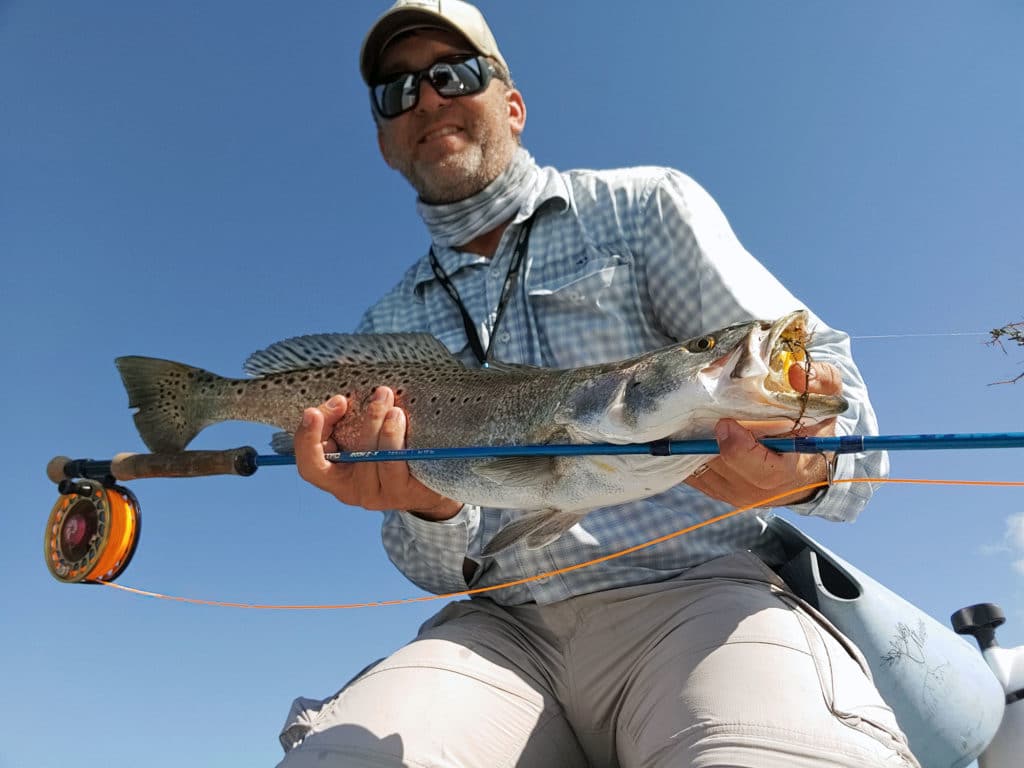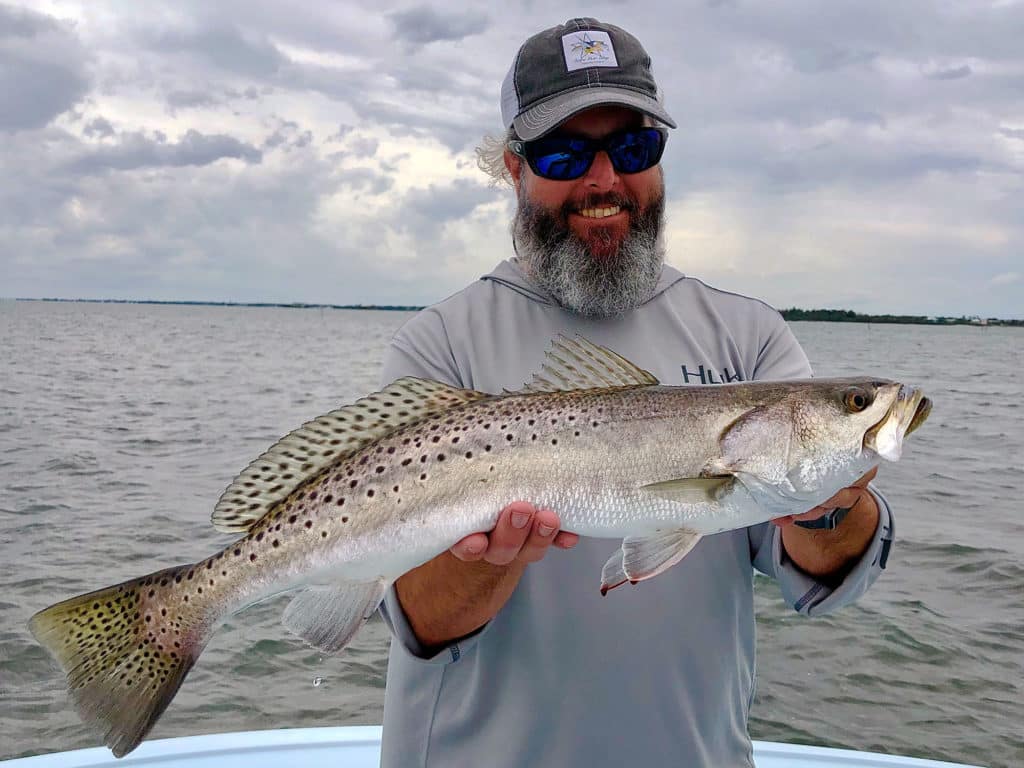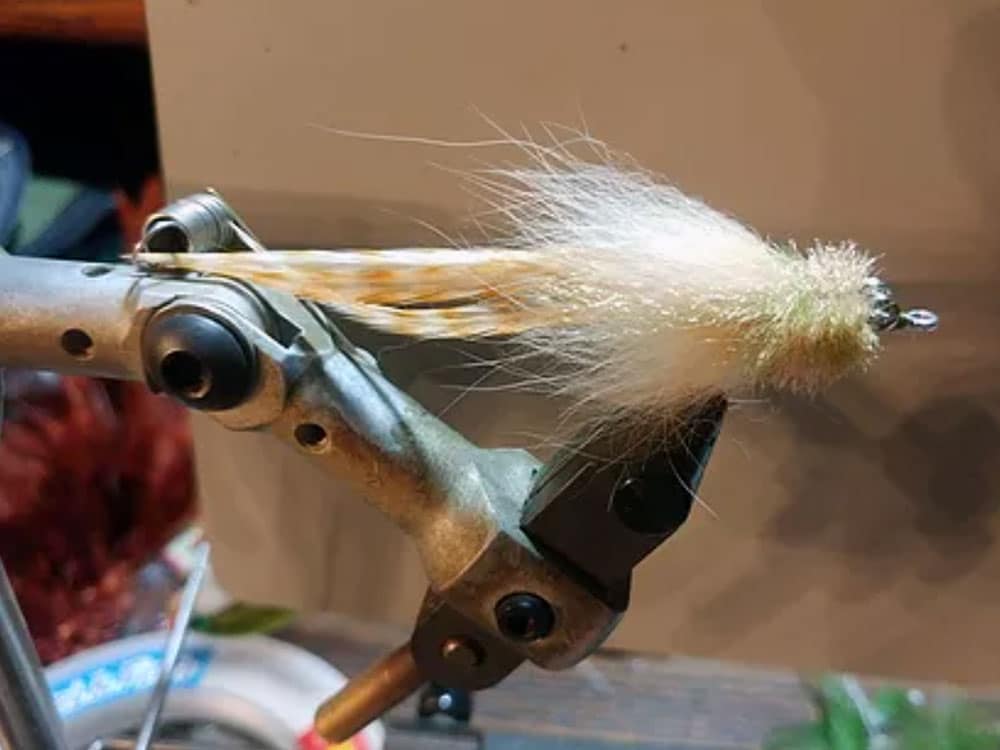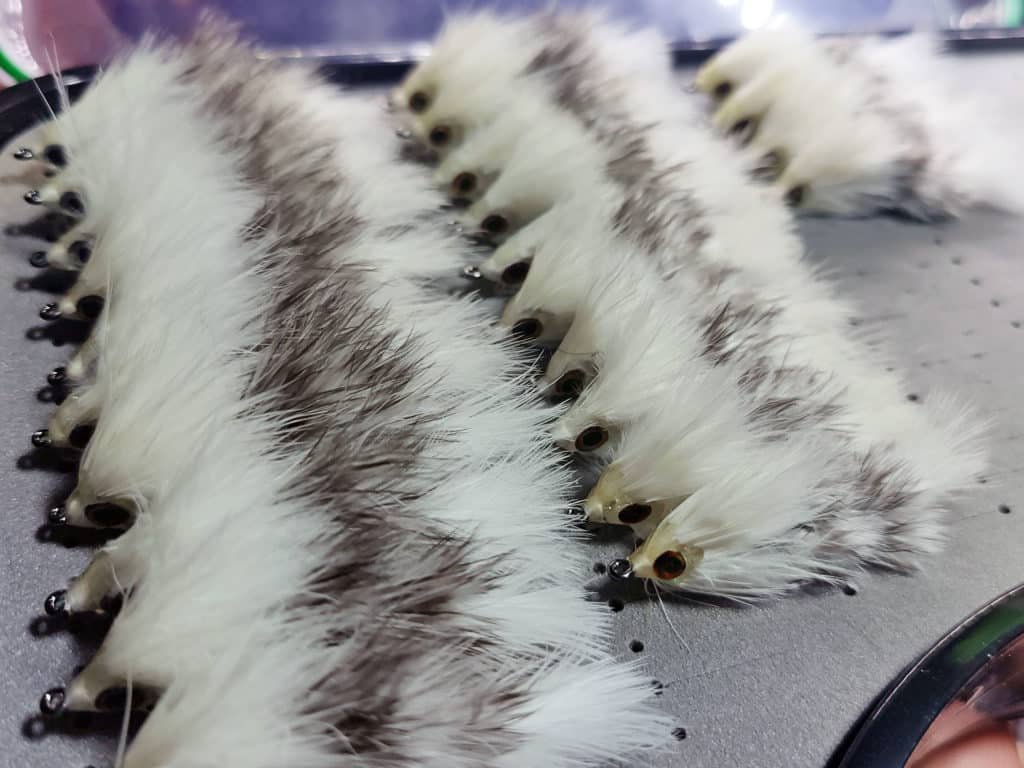
Ask someone to daydream about saltwater fly fishing and most people will picture scenes of tarpon jumping in the air, bonefish tailing on the flats, redfish cruising a shoreline, or permit screaming drag off a fly reel. These are the photos you see on magazine covers and the videos you probably watch online. However, I think there is one fish that is often overlooked by saltwater fly anglers. This fish requires casting skill, stealth, and overall knowledge. I’m talking about big spotted seatrout, often called gator trout.
I’m here to say fly anglers should start daydreaming about gator seatrout.
What Are Gator Seatrout?
For those unfamiliar with the term, a gator seatrout is just an oversized speckled seatrout. Most anglers along the Gulf and Atlantic coasts are very familiar with seatrout fishing, and locals in different spots across the Southeast have different definitions of a gator. A gator seatrout varies from location to location, since the typical size of spotted seatrout varies from one state to another. For my personal area, the Space Coast of Florida, most people consider seatrout over 27 inches to be a gator seatrout. This size makes it larger than the average catch, and well above the slot limit of 19 inches. The weight of these fish depends on the time of year, what they’re feeding on, and overall health of the fish.
We have landed fish in the 30-inch range that run 10 to 11 pounds. On the other hand, we once landed a fish that measured almost 40 inches weighing just under 8 pounds — this particular fish was spawned out and dying of old age. To me, a gator seatrout is one that makes an impression because of its size.
Gator seatrout are more than likely the spawners in your area — big female speckled trout reproducing and adding to the fish population in your area. Like size, the spawning pattern of these fish also varies from location to location. These fish need to be handled properly and released in good health so our fish populations can continue to grow. This is my plea to any anglers that target these fish: Use care and follow guidelines for a healthy release.

Where to Find Gator Speckled Trout
Where can anglers find gator seatrout? This is probably the number one question I hear during seminars. My answer is always the same. When you’re in an area that you think should hold seatrout, but aren’t seeing them, there is likely a gator seatrout around. Biologists are right about these fish — they are voracious predators. For this reason, they are typically solitary fish. The one exception I have found to this rule is when they are spawning. This seems to be the one time when smaller male trout will be daring enough to hang out with the large females. Additionally, it seems to be the one time females will tolerate the smaller fish being near them, without trying to eat them.
When my clients and I are hunting these fish, I look for shallow flats that offer protection in the form of seagrass, close proximity drop-offs, mangroves, or even drift algae. I want a location that has plenty of bait without a lot of predators in the area. Gator seatrout will often move into an area with lots of bait and drive off the other predators. On most days, gator trout are ambush predators. They will hide in the grass, mangrove shadows, or edges of the drop-offs. Watch these areas closely. If you are fortunate enough to have healthy grass beds around, in very shallow water, you may find them snaking through the grass, hunting prey.
If you are a nighttime angler, you can find these fish in the same dock and bridge lights that you find the smaller seatrout. The trick to getting the big ones is to fish the edges of the light, or to get your fly down deeper, below the bright light and into the shadows. The big ones rarely stay in the bright areas, leaving that to the smaller fish.
How Fly Anglers Can Find Gator Seatrout
Hunting gator seatrout is not the 100-yard dash, it’s a marathon. These fish have perfect camouflage for the areas they hunt and are extremely difficult to see when they are not moving. Pole your boat slowly, scanning the area as well as you can, looking for their dark shadow. The slower you move, the better chance you have of seeing them before they detect you. If you use an electric trolling motor, set it as low as possible to maintain motion and keep it at that speed — thrusting a trolling motor up and down creates too much noise.
Having proper eyewear for the conditions is a huge part of the equation too. I carry two sets of glasses at all times. One for early morning or overcast conditions, and one for those bluebird, high sun days. You want to be able to see as much detail under the water as possible. A lot of people ask for specific lens colors and that is difficult to answer — find a retailer that will let you try them on, walk outside, and see which one helps colors “pop” for you.
When fishing stealthily on the flats, pay attention close to waters near the boat. Too many anglers have the 100-yard look, trying to squint and see fish at a distance. As previously mentioned, these fish are hide-and-seek champions. Pay very close attention to the area within 30 to 45 feet of the boat. This is where you find most of your fish. In this range you can make out their shadows amongst the grasses, mangrove roots and ledges. Keep your eyes moving, looking for anything that looks out of place. We have caught several gator seatrout within 20 feet of the boat.
Finally, I’d suggest you learn and know your locations intimately. Nothing beats time on the water. This will help you recognize when conditions change suddenly in an area. When small redfish and seatrout stop biting, there is a good possibility a gator seatrout has spooked them off.
Fly Fishing Tackle for Seatrout
I have two setups that I use for these big seatrout. The only difference between them is the line weight. I determine which one I am going to use based on how the fish have been reacting: Will they allow me to use the heavier line weight without spooking? These fish are extremely important to our fish populations, so I try to use the heaviest rod I can, so I can land them quicker, revive them, and release them healthy.
My first setup is a 7-weight fly rod, with a matching reel, and either a saltwater or a bonefish taper fly line. Since the majority of the fish in my area are shallow, I use a weight forward, floating fly line. If I need to get deeper, I extend my leader and use a weighted fly. The longer taper of the bonefish fly line or the standard saltwater fly line, as opposed to a redfish taper or other blunt-tapered fly line, allows for a delicate presentation. I use a minimum of a 12-foot tapered leader, with a tippet of 12-pound test.
My second setup is a 5-weight fly rod, with a matching reel and the same type of fly line. I usually extend my leader on this outfit to 15 feet. I use this particular setup when my waters are cool, clear, and extremely shallow. This outfit is designed for delicate presentations, when I know the fish are extremely spooky.
Flies for Gator Seatrout
Fly selection will vary from location to location. A lot of it depends on the bait in your area. However, I have two flies that catch the vast majority of my gator seatrout along Florida’s east coast. When I know we are going to target big trout, they are the first flies I tie on.
The first fly was specifically developed for gator seatrout. The Spartina Turner was a fly I developed after a day of fishing for gator seatrout with Flip Pallot. We had spent a day targeting these fish, which we found laid up on the edges of potholes, along a seagrass flat. The water was clear and low, so we had to use lighter fly rods.

Unfortunately, the smaller flies we had to use on these rods wouldn’t attract the attention of big fish. So, I went home and came up with a fly that was light enough to cast on a light rod, but offered a large enough profile to interest the fish. The Spartina Turner (so named by Flip because it caused fish to turn and crush it in the grass) was born. The most important part of this tie is to use quality feathers for the tail. The longer and stiffer the feathers, the longer the profile of the fly. I use full saddles by Metz, Whiting and Ewing to tie these flies.
The second fly is a relatively new fly that Blane Chocklett made famous. The Gamechanger has been just that for these fish. Specifically, the feather Gamechanger fly. This fly has quickly become my go-to fly for gator seatrout. It lands softly, stays high in the water column, and provides ultra-realistic movement through the water. The fly undulates like no other fly out there, and I have found very few fish that can resist it. If you are not familiar with the fly, Blane has plenty of videos out there, showing how tie and fish it.

I don’t want to neglect the people that love topwater action. Besides, using a popper can be a great way to target these fish in the early morning or late afternoon, when there isn’t enough sunlight to see them. My personal popper of choice is the Crease Fly. The Crease Fly is simple to tie, can be cast by most people, and offers just enough noise to help attract fish. Don’t be surprised if you catch more than gator seatrout on them. I’ve had redfish, snook, tarpon, mangrove snapper and others crash them while fishing.
Hunting a trophy seatrout can take a lot of time and patience. More often than not, most people get lucky with them while fishing for other species. If you want the best chance at getting them, then you must dedicate time to finding them. When we hunt for these fish, we bypass everything else. Some people may think it isn’t worth it. I believe the look on my client’s face when we get a 30-inch gator boat-side is worth every bit of time and effort.









